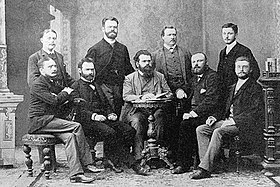Heinrich Streintz
Heinrich Streintz (born May 7, 1848 in Vienna , † November 11, 1892 in Graz ) was an Austrian physicist .

Life
After his parents moved to Graz due to their son's frequent illnesses , Streintz attended grammar school, which he graduated with honors in 1868. Already there, one became aware of his mathematical abilities, so that Streintz later studied mathematics , physics and chemistry at the University of Graz . For a time he also studied in Leipzig , Munich , and Zurich . He received his doctorate in Graz in 1872, and then studied for some time with Gustav Robert Kirchhoff and Leo Koenigsberger in Heidelberg . He then worked in Vienna with Josef Stefan at the physical institute, where he qualified as a private lecturer in 1873. In 1875 he was appointed associate professor for mathematical physics in Graz, and in 1885 he finally became a full professor there. There he worked a. a. worked with Ludwig Boltzmann and was his successor in Graz after he left for Vienna.
In his scientific work (both theoretical and experimental), Streintz dealt with probability theory , elasticity , electricity and much more. Streintz also wrote many papers and reviews for the German literary newspaper and for Austrian high schools. The treatise “The physical foundations of mechanics” (1883) became particularly well-known, in which he criticized Newton's concept of inertia and instead introduced a “fundamental body” or a “fundamental coordinate system ”, which was intended to define uniform motion more precisely. Similar considerations led shortly afterwards (1885) to the introduction of the term inertial system by Ludwig Lange .
A cousin of Heinrich Streintz, Franz Streintz (1855–1922), was also a physicist and from 1906 to 1922 professor of physics at the Graz University of Technology.
Fonts
- About the changes in the elasticity and length of a wire through which a galvanic current flows , 1873
- The electrical after-currents of transversely magnetized iron bars , 1877
- Contributions to the knowledge of elastic after-effects , 1879
- The physical foundations of mechanics , 1883
literature
- Constantin von Wurzbach : Streintz, Heinrich . In: Biographisches Lexikon des Kaiserthums Oesterreich . 40th part. Kaiserlich-Königliche Hof- und Staatsdruckerei, Vienna 1880, pp. 23–20 ( digitized version ).
- Albert von Ettingshausen : Heinrich Streintz. Obituary . In: Communications from the natural science association for Styria . 29, 1893, pp. 233-245.
- M. Schneider: Streintz Heinrich. In: Austrian Biographical Lexicon 1815–1950 (ÖBL). Volume 13, Verlag der Österreichischen Akademie der Wissenschaften, Vienna 2007–2010, ISBN 978-3-7001-6963-5 , p. 390 f. (Direct links on p. 390 , p. 391 ).
Individual evidence
| personal data | |
|---|---|
| SURNAME | Streintz, Heinrich |
| BRIEF DESCRIPTION | Austrian physicist |
| DATE OF BIRTH | May 7, 1848 |
| PLACE OF BIRTH | Vienna |
| DATE OF DEATH | November 11, 1892 |
| Place of death | Graz |